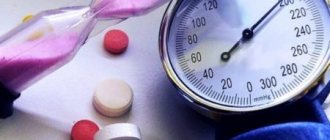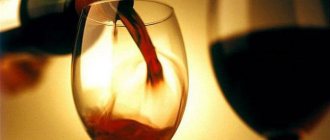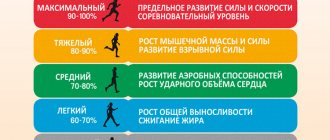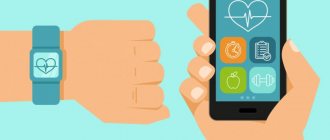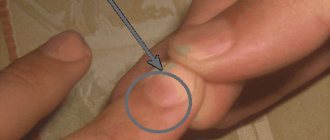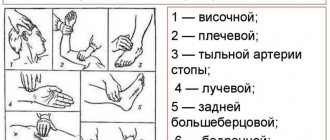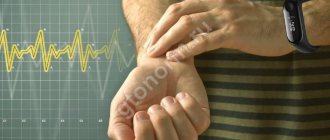Basic characteristics of pulse
What are the main parameters of this indicator of the cardiovascular system that a doctor is interested in? Experts identify six main characteristics of the pulse:
1. Rhythm - alternating oscillations of the artery walls at regular intervals. Normally, the pulse is rhythmic and the intervals of successive beats are almost equal. However, with various pathologies, this indicator is disrupted and arrhythmia occurs (that is, alternating oscillations of the arterial walls occur at different time intervals).
2. Frequency – displays the number of oscillations of arterial walls occurring in one minute. The pulse may be rare, moderate or frequent. The normal heart rate indicators depend on many factors, and the norm is estimated based on the patient’s age. In some pathologies of the heart or blood vessels, the heart rate and pulse rate may not coincide (for example, in cases where the heart chambers are not completely filled with blood).
3. Filling - reflects the volume of blood released into the arteries from the heart chambers. Normally, the lumen of the artery fills completely and vibrations of the vascular walls become more noticeable - this indicator is characterized as “full pulse”. If the pulse is difficult to palpate, the doctor characterizes it as “empty.”
4. Tension - determined by the force of pressure on the artery, which is necessary to completely stop the flow of blood in the lumen of the artery. This indicator depends on the level of systolic pressure. With hypertension, the pulse becomes hard (or tense) and effort is required to compress the artery, and a soft pulse is said to be in cases where this action is performed without much effort.
5. Size – depends on filling and voltage. It is determined by the degree of oscillation of arterial walls between contraction and relaxation, as well as the elasticity of blood vessels. There are several types of heart rate. A small pulse is provoked by narrowing of the aorta, excessive elasticity of the vascular walls or cardiac tachycardia. Large - occurs in cases where the heart pumps a larger volume of blood through overstrained blood vessels (for example, with overproduction of thyroid hormones or aortic valve defects). Intermittent - caused by severe damage to the heart muscle and appears when large and small waves alternate. A thread-like pulse is characterized by weak palpation of beats and occurs during massive bleeding or shock.
6. Shape - determined only instrumentally and reflects the rate of change in the volume of the arterial lumen when the vessel is filled with blood. When assessing this pulse parameter, the doctor can characterize it as slow, fast or dicrotic.
What does it represent?
In the large veins located next to the heart, pulse fluctuations are observed in the systolic phase of the atria and ventricles - when the myocardium contracts and blood is expelled from the heart into the vascular system. In this case, the pressure in the veins increases, their walls begin to vibrate. Normally, the venous pulse is found only in the central, usually jugular veins, which are located closer to the heart. In small blood vessels, pulse fluctuations are not detected.
Fluctuations are determined by visual signs using phlebography. Palpation is not used due to low pressure in the veins, as a result of which tension in the walls is not felt. On the phlebo-sphygmogram, the curve has a negative direction. Fluctuations in the walls of the veins are unsharp, sluggish, the rise of the pulse wave takes longer, unlike the walls of the arteries.
Non-closure of the tricuspid valve leaflets leads to pathological reflux of blood during systole from the right ventricle into the right atrium and affects the occurrence of a positive pulse. The volume of the vein increases synchronously with systole. There is a rapid movement of blood in the direction opposite to normal. A pulsation of the neck veins, noticeable to the naked eye, appears; the swelling corresponds to the systological phases.
Heart rate table by age
Normal heart rate depends on many factors: age, gender, activity (physical or emotional) or rest, level of physical fitness or the presence of diseases. Pulse rate is measured in beats per minute, and the rate of this indicator is determined by age.
Normal heart rate values for children:
| Child's age | max and min indicators | Average value |
| 0 – 1 month | 110 – 170 | 140 |
| 1 – 12 months | 102 – 162 | 132 |
| 1 – 2 years | 94 – 155 | 124 |
| 4 – 6 years | 86 – 126 | 106 |
| 6 – 8 years | 78 — 118 | 98 |
| 8 – 10 years | 68 – 108 | 88 |
| 10 – 12 years | 60 – 100 | 80 |
| 12 – 15 years | 55 – 95 | 75 |
Normal heart rates for adults:
| Age | max and min indicators | Average value |
| Up to 50 years | 60 – 80 | 70 |
| 50 – 60 years | 65 – 85 | 75 |
| 60 – 80 years | 70 – 90 | 80 |
What is the pulse like?
Experts distinguish the following types of pulse:
- arterial - has the greatest diagnostic value, occurs as a result of rhythmic jerk-like oscillations of the arterial walls when their blood supply changes during heart activity, is characterized by rhythm, frequency, filling, tension, height and shape (or speed);
- capillary (or Quincke's pulse) - detection of such a pulse is not the norm, since in healthy people the blood flow in the capillaries is continuous due to the work of the precapillary sphincters, such a pulse is determined by the intensity of the color of the nail bed, the skin of the forehead rubbed with the fingers and the lower lip pressed under the cover glass;
- venous - expressed in the pulsation of the cervical jugular veins and other large venous vessels located near the heart; it is rarely present in the peripheral veins; according to the sphygmogram and venogram, it can be characterized as negative or positive.
Video: Pulse. What does his silence say?
What does it mean if the pulse and lower pressure are the same?
Pulse and lower blood pressure may be the same normally because they have a similar range of fluctuations. Therefore, numbers in the range of 60-90 are normal for both pulse and diastolic pressure. If both indicators are significantly elevated, this means tachycardia and diastolic hypertension. This combination occurs when:
- heart attack;
- inflammation of the myocardium (myocarditis);
- congenital malformation of the aorta;
- deterioration of kidney nutrition (narrowing of the renal artery);
- damage to renal tissue due to glomerulonephritis, nephropathy, polycystic disease;
- sudden dilation of blood vessels in a state of shock (due to allergies, acute vascular insufficiency, blood loss).
Low values are typical for aortic valve insufficiency and intracranial hypertension.
Pulse and pressure do not always change simultaneously, so most often hypotension or hypertension with tachycardia or bradycardia is considered separately. To measure indicators, you need a tonometer with a pulse indication.
Why measure your pulse?
Pulse is one of the important parameters of the quality of physiological processes, reflecting the state of health, level of physical fitness or the presence of diseases of the heart, blood vessels and other systems and organs. The indicators given in the tables above are the normal heart rate for healthy people at rest. It should be remembered that any changes in the body can provoke deviations from the norm in different directions. For example, during pregnancy or menopause, hormonal changes occur that can affect the pulse rate. A person's heart rate can change under the influence of many factors.
Rapid pulse - tachycardia - can occur in the following physiological conditions or pathologies:
- emotional outburst or stressful situation;
- pregnancy;
- menopause;
- hot weather or stuffy room;
- overwork;
- high level of physical fitness;
- consumption of products containing caffeine;
- taking certain medications;
- heavy menstrual bleeding;
- severe pain;
- diseases of the endocrine and nervous system, blood vessels and heart, high temperature in some infections, neoplasms, anemia, bleeding, etc.
Physiological or pathological slowing of the pulse - bradycardia - can be provoked by the following factors:
- dream;
- high fitness of the heart muscle (in athletes, active people);
- age-related changes;
- intoxication;
- increased intracranial pressure;
- myocardial infarction;
- inflammatory processes in the tissues of the heart;
- organic heart lesions;
- peptic ulcer;
- hypothyroidism;
- taking certain medications.
Types of vein pulsation
There are three types of venous pulsation. Usually observed:
- Transmitted pulsation of veins. As a result of pulse oscillations of the carotid artery, this process spreads to the skin and neck muscles, causing the veins to move. Normally, transmission pulsation is observed in people who are easily irritated, under excessive emotional stress, and after physical exertion. This type is usually observed if a person suffers from hypertension or acquired heart disease.
- Respiratory pulsation. If there are no health problems, then this should not happen. This problem is diagnosed when a person suffers from diseases accompanied by increased pressure in the chest. Such processes are associated with emphysematous changes in the lung tissue, that is, with its increased airiness. Also, respiratory pulsation is detected if the circulatory system is oversaturated with blood in people suffering from bronchial asthma, pleurisy, and pneumothorax. This depends on inhalation and exhalation, as well as on the stage of development of the pathological process. When a person inhales, the volume of venous blood decreases, as there is passive filling of the right atrium and the appearance of negative pressure in the chest. Exhalation is accompanied by dilation of blood vessels, because the outflow of blood does not occur.
Also read: What pulse should a pregnant woman have?
There is also a third type of pulsation, which is called the cardiac pulse. It, in turn, is divided into two types:
- Negative venous pulse. If you lie down and lightly squeeze the vein, no pulsation will be observed. This is considered normal. Negative venous pulse refers to the construction or compression of the venous vessels. This occurs as the ventricles contract and blood is pumped into the arteries. In this case, blood from the vein is directed to the atrium under the negative pressure of the thoracic cell. Its volume decreases. If the condition of the body is normal, when in a horizontal position, the ventricles simultaneously contract and the jugular veins of the area above the collarbone are compressed. This is a completely normal phenomenon that does not indicate pathological processes in the body. Negative pulsation can be found in large vessels that are located near the heart.
- Positive venous pulse. In the absence of health problems, this phenomenon should not occur. This occurs when the jugular veins dilate significantly as the ventricles contract. Plus pulsation is detected in serious pathologies. Usually this phenomenon is characteristic of an acquired heart defect such as pathological processes in the tricuspid valve. At the same time, its complete closure does not occur during the systolic phase. Since the valves are not closed, blood from the ventricles enters the atrium cavity. From the atrium it spreads to the systemic circulation and causes the development of congestive processes and stasis. A similar problem can be recognized by swelling and pain in the area of the right hypochondrium, accumulation of fluid in the abdominal cavity, yellowing of the skin and mucous membranes.
If such symptoms appear, it is necessary to urgently visit a specialist, since this problem poses a serious danger to human life. The doctor will prescribe an examination and provide treatment.
What are the types of rhythm disturbances?
Normally, contractions of the heart muscle are caused by the occurrence of electrical impulses emanating from the sinus node (the main pacemaker of the heart rhythm). All contractions occur constantly and rhythmically, that is, at almost the same interval of time. And disturbances in the rhythm of the pulse, caused by incorrectly received electrical impulses, are called arrhythmia. In such cases, the pulse becomes too slow, fast, irregular or irregular.
Both functional disorders and diseases can provoke arrhythmias. Typically, the root causes of such a deviation are:
- disruption of impulse conduction through one of the nodes of the conduction system of the heart;
- changes in the formation of an impulse in one of the nodes.
Depending on the origin, arrhythmias are as follows:
| By source of occurrence |
|
| By number of sources of rhythm disturbance |
|
| According to the nature of the disturbance in the conduction of electrical impulses |
|
With changes in the occurrence of an impulse in the sinus node, the following types of arrhythmias develop:
- sinus bradycardia (55 or less beats per minute) - provoked by heart pathologies, arterial hypotension or hypothyroidism, accompanied by dizziness, feelings of general weakness and discomfort;
- sinus tachycardia (more than 90 beats per minute) - caused by strong emotional outbursts, physical exertion, fever and, sometimes, heart pathologies, accompanied by a feeling of palpitations;
- sinus arrhythmia (irregular alternation of heart beats) – often detected in adolescents and children and associated with breathing (the heart rate increases as you inhale and decreases as you exhale), usually does not require treatment;
- sick sinus syndrome (expressed in bradycardia or bradyarrhythmia with paroxysms of extrasystole and atrial fibrillation) - provoked by injuries and abnormalities in the functioning of the heart, disturbances in the functioning of the autonomic nervous system or the intake of toxic substances and drugs, occurs latently or causes weakness, fainting and palpitations .
If myocardial cells lose the ability to generate an electrical impulse into an action potential, then a person develops the following types of arrhythmias:
- extrasystole (extraordinary or premature contractions of the heart muscle, an extra heartbeat) - provoked by intense emotions, autonomic dysfunction, abuse of nicotine, caffeine and alcohol or organic pathologies of the heart, manifested in the form of pulsation in the epigastric region, pallor, increased sweating, sensations of lack of oxygen and strong tremors and fading of the heart, fainting;
- paroxysmal tachycardia (pulse rate 140 - 240 beats per minute) - attacks appear and disappear suddenly, last from several seconds to several hours, are provoked by hypertension, heart pathologies, pneumonia, sepsis, taking medications (Quinidine, cardiac glycosides, diuretics and Ephedrine) or diphtheria, are accompanied by sensations of palpitations, weakness and the presence of a lump in the throat, frequent urination and increased sweating.
The most dangerous type of heart rhythm disorder is atrial fibrillation. As a result of this deviation from the norm, a person may develop thromboembolism, cardiac arrest and heart failure. During this disorder, a person experiences chest pain, increased heart rate, ischemia of the heart muscle (up to a heart attack), signs of atrial fibrillation on the ECG and heart failure. The following factors can provoke the development of atrial fibrillation:
- heart disease;
- stroke;
- severe stress;
- taking high doses of ethanol;
- overdose of certain medications;
- surgery.
Normal indicators
Pulse arrhythmia is an abnormal heartbeat rhythm; it can be slow or rapid.
The normal (sinus) heart rate of a person is considered to be a pulse of 60-75 beats per minute. This way you can calculate the cyclicity: a pulse of 75 beats per minute is a cycle of 0.80 per second.
The heart rate of a young healthy man (from 30 to 40 years old) is 70-75 beats per minute, a woman’s is up to 80, the heart rate of a one-year-old child is more than 130 beats, and a five-year-old’s is 100.
The pulse of a healthy person changes for the following reasons:
- Temperature regime. In the cold, the heart rate decreases, in the hot season it increases.
- Hearty food. After a rich meal, increased digestion begins, which leads to an increase in heart rate.
- Physical activity, pain, fear. The body reacts to physical and emotional stress with a characteristic change in heart rate towards an increase.
- Body position. A person who is lying down has lower systolic pressure than when sitting.
Heart rate
Heart rate is the number of heart contractions per unit of time. It reflects the frequency of contractions of the ventricles of the heart in one minute and normally ranges from 60 to 80 beats (in an adult and healthy person). This indicator is often confused with the pulse, while this parameter of the cardiovascular system displays the number of oscillations of the vessel walls in response to heart contractions. Typically, both heart rate and pulse are approximately the same.
What does heart rate depend on?
Pulse characteristics may vary depending on various factors such as environment, age, physiological or pathological reasons. The gender of a person is also important, as a woman’s heart beats at a higher speed than a man’s. To summarize, heart rate largely depends on the reasons:
- Physiological, such as load, stress, food consumption and digestion. There are drinks that have a significant effect on the pulse. These are caffeine-containing products, including Coca-Cola and alcohol. Smokers also have a faster heart rate. Sleep and monotonous work help slow down the process of ventricular fibrillation and the ejection of blood.
- Pathological, for example, infectious diseases, hypertension, neoplasms, asthma, bronchitis, heart attack, large blood loss. Often the cause of a slow heart rate is a side effect of certain medications. If the heart is malfunctioning, then the pulse waves will be irregular, and if the veins in the arms and legs are blocked, they will be completely absent.
Pulse form
The shape of the pulse reflects the rate of change in pressure between contraction and relaxation of the heart muscle. Depending on these indicators, doctors distinguish the following forms of pulse fluctuations:
- rapid pulse - is a sign of aortic insufficiency or thyrotoxicosis, occurs due to the fact that a lot of blood is pushed out of the ventricles and the pressure during diastole decreases sharply;
- slow pulse - occurs with mitral regurgitation or narrowing of the aortic walls, manifested by small pressure drops;
- dicrotic pulse - appears when the tone of peripheral vessels deteriorates and is manifested by the passage of an additional wave of oscillations through the vessels.
What is this concept
Pulse indicators indicate how efficiently the heart works and indicates the condition of the blood vessels. To determine it, they usually probe the arteries or use heart rate monitors. To feel this indicator on the back of the forearm, you need to position your wrist. The radial artery is better visible in this area.
Objective pulse indicators can be recorded using a sphygmogram.
Healthy people have a high pulse wave, which rises steeply and falls slowly.
In some cases, a change in the pulse wave may occur. Dicrotism is also observed.
In Greek, the term means two strikes. From which it follows that pulse dicrotia is a condition in which the pulse wave is repeated twice when the heart contracts once.
The size of the second wave is much smaller than the first one. Its development is associated with the reverse movement of blood through the vessels, which reflects after the closure of the aortic valve.
How to properly examine the pulse?
The arterial pulse is most easily measured with a finger, while the venous and capillary pulse cannot be determined by palpation and are measured using special techniques. In some cases, to study the arterial pulse, the patient is prescribed the following instrumental methods:
- sphymography;
- sphygmomanometry;
- ECG or Holter ECG;
- Pulse symmetry.
Pulse counting can be done by yourself, a loved one, or a doctor. Remember, the person who is taking the pulse must be relaxed and emotionally calm, his hand must be in a comfortable position!
Video: How to measure pulse
Most often, the measurement is performed by palpating the radial artery at the wrist. To do this, press the artery with two or four fingers so that the fingertips feel the vibrations of the arterial walls. After this, they note the time (it is better to do this with a stopwatch) and begin to count the pulse. The number of vibrations of the arterial walls can be calculated in 1 minute, and if the pulse is rhythmic, then the measurement can be accelerated by counting the frequency of beats in 30 seconds and multiplying the result by 2.
Sometimes the pulse is measured in other arteries:
- ulnar - on the bend of the elbow or in the center of the wrist;
- carotid - on the neck on the side of the thyroid cartilage and closer to the chin;
- axillary - at the level of the edge of the first rib;
- femoral - on the inner side of the thigh (closer to the pubic symphysis);
- temporal - on the temple just above the cheekbone.
How to calm arrhythmia
At home, you can try to calm the arrhythmia only if the symptoms are mild. In this case, you need to strictly monitor the condition and at the first deterioration, do not hesitate to call an ambulance.
Basic techniques for stopping an attack of tachycardia and atrial fibrillation:
- Do not press too hard on the eyeballs.
- Massage the carotid sinus.
- Inducing vomiting artificially.
- While taking a deep breath, you hold your breath.
- You can drink a glass of cool plain water.
Arrhythmia due to chronic fatigue or frequent worries can be eliminated by counting out loud. To do this, you need to sit in a comfortable position, feel the pulse on your left hand and start counting out loud. Even if the rhythm is incorrect, you should try to count evenly, ignoring any disturbances that arise. Gradually, cardiac activity will improve.
First aid for bradycardia:
- Take a foot or semi-sitz hot bath.
- Drink strong coffee or black tea.
- Take a walk in the fresh air.
- Do physical exercises.
If there is no result from the above actions, you need to lie on your back and raise your legs above body level, for which a cushion or pillow is placed.





